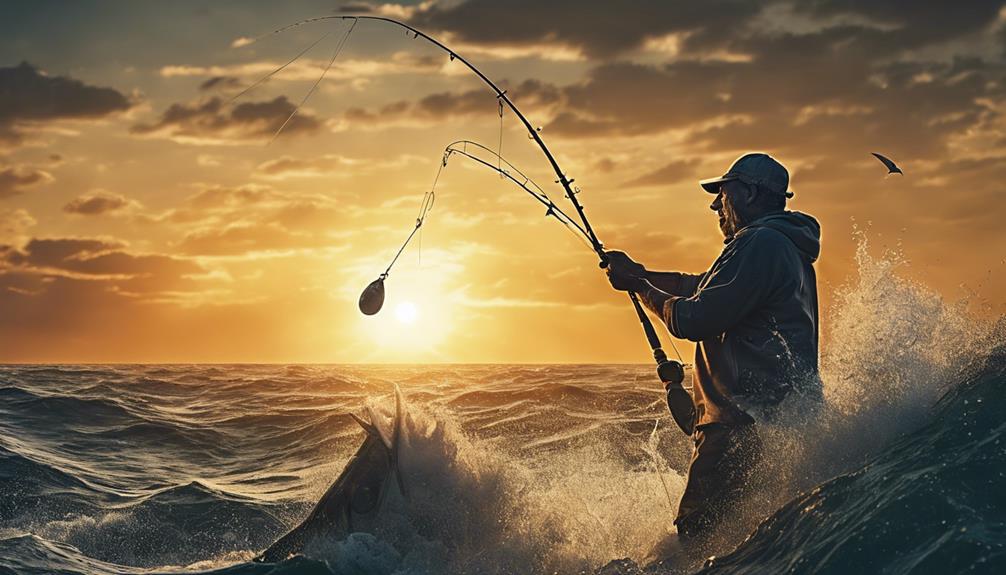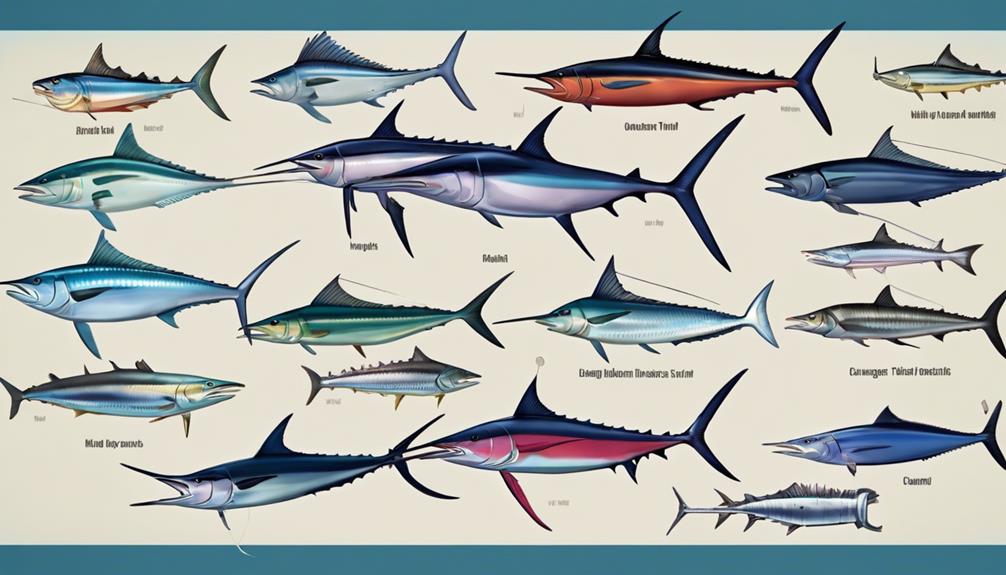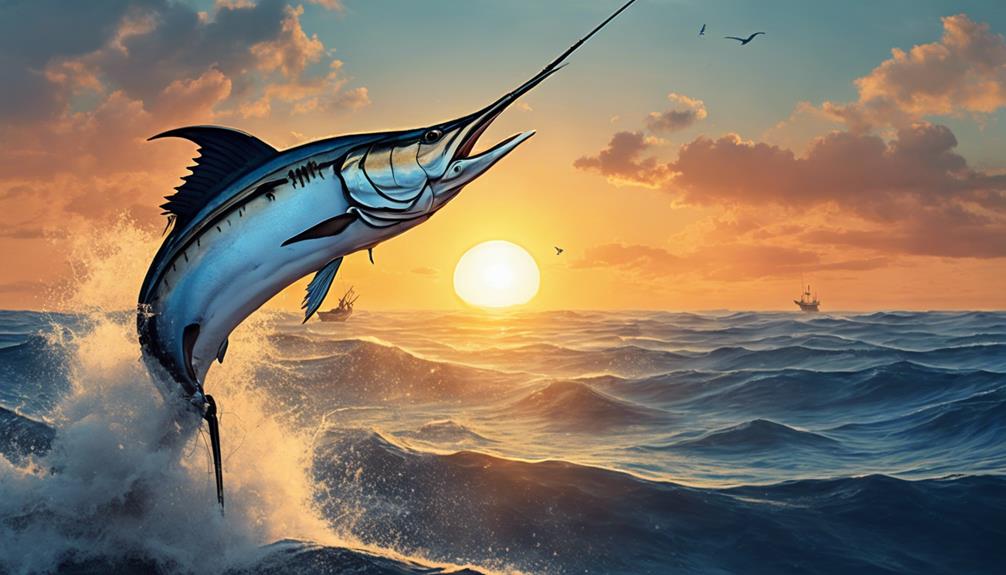Imagine you are out at sea, trolling for marlin with a top-notch setup. Suddenly, your rod bends, the line screams off the reel, and you find yourself in a thrilling battle with a powerful fish.
But what exactly makes trolling so effective in deep sea fishing? The answer lies in a combination of factors that can significantly increase your chances of landing that trophy catch.
Benefits of Trolling in Deep Sea Fishing
Trolling in deep sea fishing offers numerous advantages, including covering more ground to increase your chances of catching a variety of fish species. By employing different trolling techniques, you can optimize your catch efficiency and make the most out of your fishing expedition.
One of the key benefits of trolling is the ability to cover a larger area compared to traditional fishing methods. Instead of staying in one spot and waiting for fish to come to you, trolling allows you to actively search for fish by moving your bait or lures through the water. This increased mobility means you can explore different depths and locations, increasing your chances of encountering various fish species.
Moreover, trolling techniques such as using planers, downriggers, or divers can help you target specific depths where fish are more likely to be found. By adjusting the depth at which your bait or lures are presented, you can effectively reach the desired fish zone and improve your catch efficiency. These techniques allow you to adapt to changing conditions and increase your chances of a successful fishing trip.
Best Equipment for Trolling
When outfitting for effective deep sea fishing, selecting the right equipment is crucial to enhance your trolling experience and optimize your catch potential. Here are some key pieces of equipment that can help you make the most out of your trolling techniques:
- Quality Fishing Rods: Invest in sturdy fishing rods specifically designed for trolling. Look for rods that have a sensitive tip to detect bites, but with enough backbone to handle larger deep-sea species. Consider the length and action of the rod based on the type of fish you're targeting.
- Durable Reels: Pair your fishing rods with high-quality reels that have a smooth drag system. Opt for reels with a high line capacity to handle the long runs that can occur during deep sea trolling. Look for reels that are corrosion-resistant since saltwater conditions can be harsh on equipment.
- Rod Holders: Utilize rod holders to keep your trolling rods secure and in position while waiting for a strike. Rod holders help free up your hands for other tasks on the boat and ensure that your rods are at the optimal angle for trolling. Make sure the rod holders are adjustable to accommodate different rod lengths and angles.
Targeting Specific Deep Sea Species
To effectively target specific deep sea species, understanding their behavior and preferred habitats is essential for a successful fishing expedition. When it comes to bait selection, different species have varying preferences. For example, mahi-mahi are often attracted to brightly colored lures, while marlin tend to go for larger baitfish. Researching the specific species you're targeting will help you choose the most enticing bait for your trolling setup.
Rod positioning is another crucial factor in targeting specific deep sea species. Some fish, like tuna, are known to swim closer to the surface, so positioning your rods at different depths can increase your chances of a successful catch. Additionally, using outriggers or downriggers can help you cover more water and present your bait at the right depth for the species you're targeting.
When preparing for your deep sea fishing expedition, take the time to study the behavior and habitat preferences of the species you're aiming to catch. By selecting the appropriate bait and strategically positioning your rods, you can maximize your chances of attracting the specific deep sea species you're after. Remember, attention to detail and a tailored approach are key when targeting specific deep sea species.
Trolling Speed and Depth Control
Achieving optimal trolling speed and maintaining control over the depth at which your bait is presented can significantly impact your success in targeting specific deep sea species. To enhance your trolling technique's precision, consider the following:
- Speed Control: Adjusting your trolling speed is crucial in deep sea fishing. Different species have varying preferences when it comes to lure speed. For example, high-speed trolling is often effective for species like Wahoo, while Marlin might be more enticed by a slower pace. Experiment with different speeds to find the optimal one for the species you're targeting.
- Depth Coordination: Controlling the depth at which your bait runs is essential for attracting the right fish. This can be achieved through various methods such as using downriggers, diving planers, or adjusting the length of your line. Understanding the depth at which your target species usually feed will help you set up your trolling equipment more effectively.
- Monitoring Equipment: Invest in quality depth finders and fish finders to assist you in maintaining the desired depth. These tools can provide real-time data on the depth of your bait, allowing you to make immediate adjustments if needed. Keeping a close eye on your equipment will help you stay in control of your trolling speed and depth, increasing your chances of a successful deep-sea fishing excursion.
Importance of Using Lures
Utilizing lures is essential for enticing deep sea fish and increasing your chances of a successful catch. When it comes to lure selection, it's crucial to consider the type of fish you're targeting and the conditions of the water. Different lures mimic various prey, such as squid, fish, or shrimp, so choosing the right one can make a significant difference in your trolling success. Additionally, mastering casting techniques is key. Make sure to vary your casting distance and speed to cover a wider area and attract more fish.
Another important aspect to consider is the hook size and line strength. The size of the hook should match the bait you're using and the type of fish you're aiming to catch. Using a hook that's too large or too small can result in missed opportunities or losing the fish during the fight. Moreover, ensuring your line strength is appropriate for the targeted species is vital. Deep sea fish can put up a strong fight, so having a robust line that can withstand their pull is essential for a successful catch.
Strategies for Trolling Success
Considering the importance of using lures to enhance your deep sea fishing experience, mastering effective strategies for trolling success can greatly increase your chances of a rewarding catch. To maximize your trolling success, here are three key strategies:
- Trolling Techniques: Utilize a variety of trolling techniques to attract different species of fish. Experiment with methods such as zig-zagging, figure-eight patterns, or consistent trolling speeds to determine what works best in different conditions. Varying your trolling depth by using diving planes or downriggers can also help you target fish at different levels of the water column.
- Bait Selection: Selecting the right bait is crucial for successful trolling. Consider the type of fish you're targeting and choose bait that mimics their natural prey. Live bait like squid, herring, or mackerel can be highly effective, but don't underestimate the power of artificial lures. Brightly colored lures that mimic the movement of injured fish can entice predatory species to strike.
- Adaptability: Be prepared to adapt your trolling strategies based on the conditions you encounter. Pay attention to factors such as water temperature, currents, and weather patterns, and be willing to switch up your trolling speed, depth, or bait selection if you're not getting bites. Flexibility is key to success in deep sea trolling.
Safety Measures While Trolling

To ensure a safe deep sea fishing experience while trolling, prioritize proper equipment maintenance and adherence to boating regulations. Regularly inspecting your boat, fishing gear, and safety equipment is crucial. Make sure life jackets are in good condition and accessible, and that communication devices are working. Familiarize yourself with emergency protocols and conduct safety drills with everyone on board. In case of an emergency, knowing how to react swiftly can make a significant difference.
When heading out for a trolling session, always check weather conditions and conduct a risk assessment. Keep an eye on weather forecasts and be prepared for unexpected changes. High winds and rough waters can pose serious risks, so it's essential to evaluate if it's safe to proceed. Your safety and that of your fellow anglers should always come first.
Additionally, ensure that all passengers are aware of safety procedures and that everyone wears appropriate safety gear. Establish clear communication channels among the crew and designate roles in case of emergencies. By being proactive about safety measures and staying vigilant throughout your deep sea fishing trip, you can minimize risks and ensure a more enjoyable experience for everyone on board.
Sustainable Trolling Practices
When engaging in deep sea fishing through trolling, prioritize sustainable practices to preserve marine ecosystems and ensure long-term fishing viability.
To achieve this, consider the following:
- Conservation Measures: Implementing conservation measures such as adhering to catch limits, using circle hooks to minimize harm to non-target species, and releasing undersized or protected fish back into the ocean can help maintain healthy fish populations and biodiversity.
- Ethical Harvesting: Engage in ethical harvesting practices by avoiding sensitive habitats, steering clear of spawning grounds, and respecting marine protected areas. By doing so, you contribute to the overall health of the marine environment and promote responsible fishing behavior.
- Eco-Friendly Practices: Embrace eco-friendly practices like using biodegradable or non-toxic fishing gear, reducing plastic waste onboard, and properly disposing of any trash or debris. These actions help mitigate the impact of fishing activities on the ocean and its inhabitants, fostering a more sustainable approach to deep sea trolling.
Frequently Asked Questions
How Does Trolling in Deep Sea Fishing Compare to Other Fishing Techniques in Terms of Efficiency and Success Rate?
When you compare trolling to jigging in deep sea fishing, trolling often yields higher success rates. Trolling involves dragging lures or bait behind a moving boat, covering more water and enticing a wider range of fish species. This technique increases your chances of hooking a big catch.
Success rates in trolling are typically higher due to the active and dynamic nature of the method, offering a more efficient way to target deep-sea fish.
Are There Any Specific Techniques or Strategies for Trolling in Deep Sea Fishing That Are Not Commonly Known or Discussed?
When trolling in deep sea fishing, lure selection plays a crucial role. Varying your trolling speed can attract different fish species. Proper rod positioning and bait presentation are key for success. Trying different techniques and adjusting based on conditions can make a big difference.
Experiment with depths and patterns to find what works best for you. Remember, in deep sea fishing, being adaptable and observant can lead to a more fruitful fishing experience.
What Are the Potential Risks or Challenges Associated With Trolling in Deep Sea Fishing, and How Can They Be Mitigated?
When trolling in deep sea fishing, challenges like equipment malfunctions or rough weather can arise. To mitigate risks, always ensure safety by checking gear before heading out, and have proper precautions in place.
Stay informed about weather conditions and have emergency plans ready. By being prepared and taking necessary safety measures, you can navigate the challenges of trolling in deep sea fishing more effectively.
How Does the Depth and Speed of Trolling Affect the Likelihood of Catching Specific Deep Sea Species?
When trolling in deep sea fishing, the depth and speed you choose have a significant impact on catching specific species. Adjusting these factors based on the impact of current, temperature variations, and moon phases can boost your success rate.
Deeper trolling may attract certain species, while faster speeds could entice others. Consider these variables to optimize your chances of landing the fish you're targeting in deep waters.
Are There Any Regulations or Restrictions in Place Regarding Trolling in Deep Sea Fishing, and How Can Anglers Ensure They Are in Compliance With These Guidelines?
When it comes to deep sea fishing, regulations play a crucial role in ensuring sustainability. To stay in compliance, anglers must familiarize themselves with the rules governing trolling. Techniques and strategies for successful deep sea trolling should always align with these regulations.
Conclusion
In conclusion, trolling is an effective technique in deep sea fishing due to its ability to cover more ground, target specific species, and control speed and depth. Using the right equipment, lures, and strategies can greatly increase your chances of success.
It's important to practice safety measures and sustainable trolling practices to protect the marine environment and ensure a successful fishing experience.
Keep trolling and reeling in those big catches!



